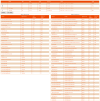JamesBowen
19+ years progress programming and still learning.
It could also be sorting that causes the extra reads... you can compile with an XREF and look for SORT-ACCESS.
Doh! I do have have SORT-ACCESS coming up in my XREF-Compile. I've been ignoring this thinking it normal behaviour.
SORT-ACCESS:
Indicates that the query result is to be ordered by a particular column value and no suitable index exists. A sort of the query result on the noted column value is required.
Now I'm unsure what index is now required. However I do believe that 'SORT-ACCESS' is legitimate because I'm using BREAK BY for the ACCUMULATE statements.

